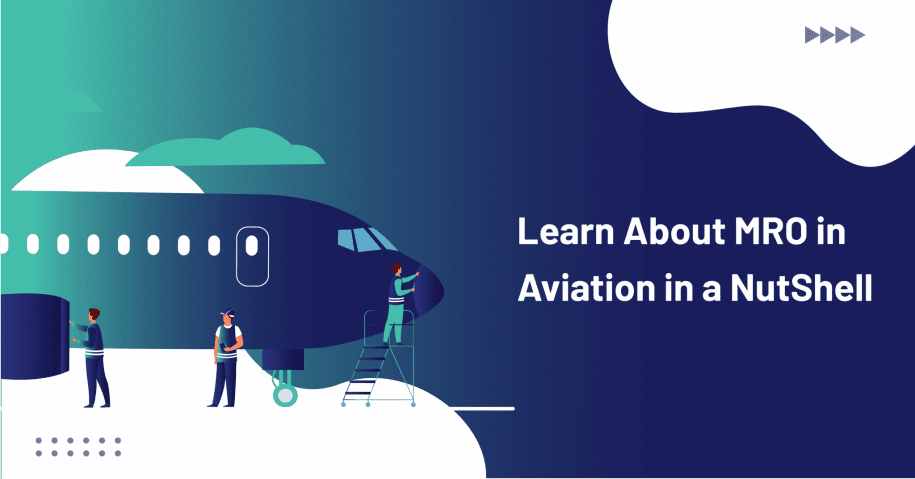MRO in aviation, i.e., “Maintenance, Repair and Overhaul”, focuses on inspecting and correcting problems in aircraft components to ensure that they remain functional and reliable to render the aircraft flightworthy. The annual revenue of the global aircraft MRO business was approximately $81.9 billion in 2019. It is projected to surpass $115 billion within the next decade. From 2012 to 2020, its CAGR (Compounded Annual Growth Rate) was an astounding 3.80%, signifying the growing importance of MRO.
From the perspective of the Indian MRO landscape, the industry is projected to grow from $1.7 billion to $4.0 billion from 2021 to 2031. The 8.9% CAGR will surpass the estimated global CAGR of 5.6%. With Indian aviation companies scheduled to deliver 1000+ commercial passenger aeroplanes soon, it implies that about 250+ significant repairs and overhauls have to be carried out annually. Defence aircraft purchase is also peaking, creating scope for military MRO.
But how exactly is MRO carried out and keeping up with the changing times? Read on to find out more.
Major MRO Operation Types
Maintenance, repair and overhaul of aeroplanes involve an array of operations to ensure the arresting of premature failures, the longevity of planes, maintenance cost optimisation, meeting business delivery agreements and rendering the ageing fleet suitable for re-delivery. The core types of MRO have been classified below:
1) Engine Overhauling
Once the aircraft completes 5000 hours of flying, its engine is overhauled. This involves –
- Servicing the Auxiliary Power Unit (APU) and maintaining the engine on-wing
- Replacing critical engine spares as needed
- Engine pooling and Engine Condition Monitoring (ECM) for proactive problem detection
- Reducing scrappage of parts to facilitate better in-house repairing
- Engine failure investigation
2) Airframe Maintenance
This MRO involves a comprehensive structural checking of the aircraft’s body and is usually undertaken every 4-5 years. Major activities include –
- Assessing structural integrity and evaluating tolerance to damage agents, environment and fatigue
- Identifying concealed signs of structural deterioration and susceptibility of the airframe to damaging sources
- Inspecting airframe holistically to troubleshoot problems, upgrading, refurbishing etc.
3) Line Maintenance
This is done during turnarounds by ground support staff. Key aspects are –
- Maintenance once the aircraft flies for 100-150 hours
- Changing of LRUs (Line Replaceable Units)
- In-service inspection, minor rectifications and troubleshooting
4) Component MRO
This MRO is carried out every 500-600 hours of flight operation. The different activities involved are –
- Maintaining critical components to ensure their sustained qualitative performance and reliability
- Removing components that have outlived their useful service lives
- Monitoring dimensional characteristics, functions and operational parameters of spares to assess their operational suitability
Prominent MRO Infrastructural Facilities
Facilities that help expedite aviation MRO in a streamlined manner have been briefly discussed below:
1) Independent Repair Stations
- Can be small stations offering specialised services in airframe or landing gear MRO
- Sometimes run by larger firms for attending to the problems of different aircraft types
2) Fixed-Base Operators (FBOs)
- Stationed at airports for offering different Line MRO services
- Full repair service also available in in-built MRO facilities
3) Commercial Airline Hubs
- Owned, operated and maintained by commercial airlines operating at a large scale
- In-house technicians and mechanics attend to all MRO jobs to optimise fleet utilisation
- Situated at major hubs of airliners
4) Regional Airline Facility
- Facility maintained by airlines operating from regional and smaller airports
- Such airlines don’t construct their own hubs at large airports but carry out MRO in spaces leased from the FBO
- Cost-saving is accomplished by allocating repair jobs between sub-contractors and their own staff
5) In-House Corporate Facility
- Built by large corporations owning and operating corporate jets
- In-house operational support staff and mechanics attend exclusively to such flights
6) Military Facility
- This facility operates on a large scale and involves the use of comprehensive and advanced assets for efficient repairing
- Maintenance is done for military cargo planes, jet fighters, helicopters etc.

Cutting-Edge Technological Interventions in the MRO Landscape
The aircraft maintenance industry is leveraging contemporary and state-of-the-art technologies to reinforce MRO capabilities. Efficiency and productivity improvements are being ushered in by:
1) Internet of Things (IoT)
2) Big Data Analytics
3) Artificial Intelligence (AI)
4) Augmented Reality (AR)
5) Robotics
6) Machine Learning (ML)
The technologies mentioned above are turbocharging aviation MRO in the following ways:
- IoT-enabled sensors provide big data whose analytical insights are streamlining CBM (Condition Based Monitoring)
- Informed CBM decisions can be made about fleet safety, reliability and availability with real-time data
- Maintenance delays are being averted through proactive fault detection and securing insights into the problem’s source
- Technicians can access IoT big data at the site through wearables powered by Pebble Watch/ Google Glass to immediately resolve the aircraft’s critical problems
- AI-powered robots are being developed for performing scheduled maintenance and eliminating the need for removing the engine for servicing
- AR is connecting licensed technicians with onsite operators across the globe to share maintenance-related expertise remotely
- AR and AI are facilitating the training of mechanics with real-time inputs and data for strategic decision making to expedite their licensing process
- Data modelling and ML capabilities are being amalgamated to strengthen predictive maintenance to avoid major cost outlays once an unchecked problem blows out of proportion
How Does RecoSense Help the Aviation MRO Industry?
RecoSense is a trailblazer MRO software developer offering intuitive and futuristic technology-powered MRO systems that improve service efficiency while curtailing costs. The cutting-edge solutions provided by RecoSense help airlines vault over MRO challenges with ease through the provision of accurate, actionable, insightful, real-time and analytical data. Repairing can be carried out with a faster turnaround time through solutions designed to be customer-friendly, facilitating service level compliance and meeting complex business-level strategic agreements.
RecoSense offers the complete spectrum of MRO-oriented services under one roof. These include scheduling manual servicing work, job estimation, making available resources visible, managing resources and manpower efficiently, etc.
Predictive Maintenance: AI in predictive maintenance helps in anticipating when machinery or equipment, such as aircraft components, will require maintenance or repairs. The AI analyzes historical data, real-time sensor data, and maintenance records to predict potential failures or issues. In the aviation MRO industry, predictive maintenance helps organizations schedule maintenance proactively, reducing downtime, cutting costs, and enhancing safety by addressing problems before they become critical.
Support Engineering Team: Intelligent AI-powered platforms like Querysense make data retrieval much faster than the traditional system. Powerful NLQ engine lets the support engineering team quickly retrieve records, and technical information easily by simple conversation like search queries. Overall, the AI platform streamlines communication and knowledge retrieval, making it easier for engineers to access information and expertise, ultimately improving efficiency and problem-solving within the team.
Risk Management and Critical Event Identification: AI platforms can do more than just retrieve and predict information. Machine learning systems can analyze a variety of data sources, including historical incident data, weather patterns, maintenance records, and more. This allows them to identify potential risks and critical events such as equipment failures, adverse weather conditions, or safety hazards. By proactively identifying these risks, aviation MRO organizations can take preventive measures, enhance safety protocols, and mitigate potential disruptions.
Vendor Quote Analysis: Vendor quote analysis in the aviation MRO industry involves using AI to assess and compare quotes or proposals from different suppliers or service providers. AI algorithms analyze the quotes for various factors, including cost, lead time, quality, and past performance. This analysis helps organizations make informed decisions when selecting vendors, ensuring they choose the most cost-effective and reliable partners for their maintenance and repair needs.
The digital framework has been built as a scalable ecosystem with real-time dashboards that foster collaboration and offer undiluted insights into maintenance’s state of affairs. AI-driven ML algorithms are capable of pre-emptively spotting subsystem failures and predicting spares and maintenance needs to ensure the airworthiness of the aircraft.


Leave a Reply